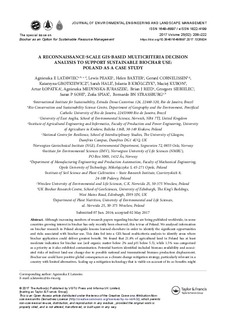| dc.contributor.author | Latawiec, Agnieszka E. | |
| dc.contributor.author | Peake, Lewis | |
| dc.contributor.author | Baxter, Helen | |
| dc.contributor.author | Cornelissen, Gerard | |
| dc.contributor.author | Grotkiewicz, Katarzyna | |
| dc.contributor.author | Hale, Sarah | |
| dc.contributor.author | Królczyk, Jolanta B. | |
| dc.contributor.author | Kubon, Maciej | |
| dc.contributor.author | Łopatka, Artur | |
| dc.contributor.author | Medynska-Juraszek, Agnieszka | |
| dc.contributor.author | Reid, Brian J. | |
| dc.contributor.author | Siebielec, Grzegorz | |
| dc.contributor.author | Sohi, Saran P. | |
| dc.contributor.author | Strassburg, Bernardo BN | |
| dc.date.accessioned | 2017-07-26T07:21:32Z | |
| dc.date.available | 2017-07-26T07:21:32Z | |
| dc.date.created | 2017-07-20T11:11:08Z | |
| dc.date.issued | 2017 | |
| dc.identifier.citation | Journal of Environmental Engineering and Landscape Management. 2017, 25 (2), 208-222. | |
| dc.identifier.issn | 1648-6897 | |
| dc.identifier.uri | http://hdl.handle.net/11250/2449362 | |
| dc.description.abstract | Although increasing numbers of research papers regarding biochar are being published worldwide, in some countries growing interest in biochar has only recently been observed; this is true of Poland. We analysed information on biochar research in Poland alongside lessons learned elsewhere in order to identify the significant opportunities and risks associated with biochar use. This data fed into a GIS-based multicriteria analysis to identify areas where biochar application could deliver greatest benefit. We found that 21.8% of agricultural land in Poland has at least moderate indication for biochar use (soil organic matter below 2% and pH below 5.5), while 1.5% was categorized as a priority as it also exhibited contamination. Potential barriers identified included biomass availability and associated risks of indirect land-use change due to possible national and transnational biomass production displacement. Biochar use could have positive global consequences as a climate change mitigation strategy, particularly relevant in a country with limited alternatives. Scaling up a mitigation technology that is viable on account of its co-benefits might be cost-effective, which could, in turn, adjust national perspectives and stronger involvement in developing mitigation policies at the regional level. Biochar has much promise in temperate conditions and further research should therefore be assigned to explore biochar’s environmental and socio-economic impacts. | |
| dc.language.iso | eng | |
| dc.title | A reconnaissance-scale GIS-based multicriteria decision analysis to support sustainable biochar use: Poland as a case study | |
| dc.type | Peer reviewed | |
| dc.type | Journal article | |
| dc.description.version | publishedVersion | |
| dc.source.pagenumber | 208-222 | |
| dc.source.volume | 25 | |
| dc.source.journal | Journal of Environmental Engineering and Landscape Management | |
| dc.source.issue | 2 | |
| dc.identifier.doi | 10.3846/16486897.2017.1326924 | |
| dc.identifier.cristin | 1482666 | |
| cristin.unitcode | 7452,35,0,0 | |
| cristin.unitname | Miljøteknologi | |
| cristin.ispublished | true | |
| cristin.fulltext | original | |
| cristin.qualitycode | 1 | |
